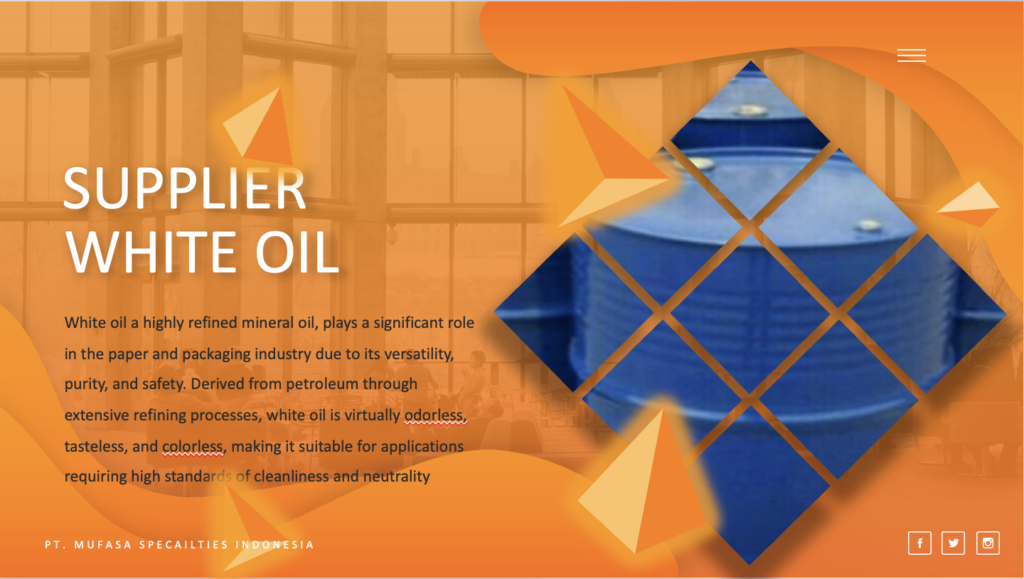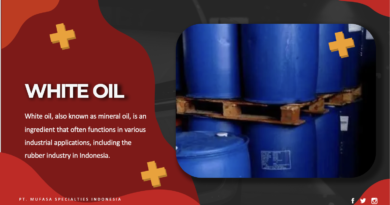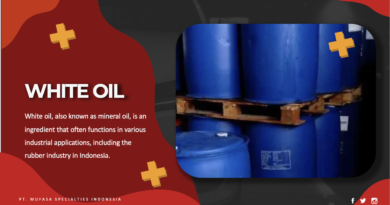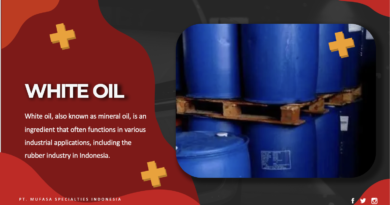
Supplier White Oil
Supplier White oil a highly refined mineral oil, plays a significant role in the paper and packaging industry due to its versatility, purity, and safety. Derived from petroleum through extensive refining processes, white oil is virtually odorless, tasteless, and colorless, making it suitable for applications requiring high standards of cleanliness and neutrality. Its utility in stems from its unique properties, which enhance the performance, durability, and aesthetics of products while complying with stringent safety regulations. Moreover, its adaptability ensures that it meets various industrial requirements effectively.
Supplier White Oil in the Paper and Packaging Industry
The physical and chemical properties of white paraffin oil make it ideal for various industrial uses. These properties include:
- Purity: White oil is free from impurities such as sulfur and aromatic hydrocarbons, ensuring compatibility with sensitive materials and processes. Furthermore, its high level of refinement contributes to the safety and stability of products used in both industrial and consumer applications.
- Stability: It is non-volatile and resistant to oxidation, which contributes to its long shelf life and consistent performance under different conditions. Therefore, this stability ensures that the material’s quality remains intact even under demanding storage and operational environments.
- Lubricity: White oil’s excellent lubricating properties reduce friction and wear during manufacturing processes. Consequently, this characteristic is particularly important for maintaining the efficiency and longevity of production equipment, as it minimizes energy consumption and maintenance costs.
- Inertness: Being chemically inert, white paraffin oil does not react with other substances, making it safe for use in applications involving food-grade and pharmaceutical-grade packaging. Hence, its non-reactive nature is vital in preventing contamination or undesirable chemical interactions.
- Viscosity: The oil’s range of viscosities allows for tailored application depending on specific requirements. Thus, this adaptability enables manufacturers to select the most appropriate viscosity grade for their unique processes and end-product characteristics.
Applications in the Paper and Packaging Industry
Supplier White oil One prominent use in the paper industry is as an anti-dust agent. When applied to paper surfaces, binds fine particles, reducing dust generation during handling, processing, and transportation. Therefore, this is particularly important for packaging materials used in environments where cleanliness is critical, such as food and pharmaceutical industries. Consequently, reduced dust levels contribute to improved workplace safety and product integrity.
1. Moisture Barrier
White oil serves as an effective moisture barrier in packaging applications. By coating paper and cardboard surfaces, it prevents water absorption, maintaining structural integrity and durability. This is essential for packaging materials exposed to humid or wet conditions. In addition, the moisture-resistant properties are critical for maintaining the freshness and quality of perishable goods. Consequently, it ensures that products reach consumers in optimal condition.
2. Gloss Enhancement
In the production of high-quality printed packaging, white paraffin oil enhances surface gloss and smoothness. Specifically, the application of a thin layer improves the visual appeal and tactile properties of the material, making it suitable for premium packaging solutions. Enhanced gloss not only improves aesthetics but also supports branding efforts by making printed designs appear more vibrant and attractive. As a result, businesses can create a lasting impression on consumers.
3. Lubrication in Machinery
White mineral oil lubricating properties are utilized in machinery involved in paper and packaging production. It minimizes wear and tear on equipment such as rollers, cutters, and printers, ensuring efficient operations and reducing maintenance costs. Proper lubrication extends the lifespan of machinery components and reduces the frequency of downtime. Thus, it significantly boosts overall productivity and ensures uninterrupted operations.
4. Food-Grade Applications
For packaging in the food industry, white oil’s purity and safety are paramount. It is used in the production of waxed paper and cardboard for food containers, providing a non-toxic and odorless barrier that complies with food safety standards. also plays a role in preventing the transfer of harmful substances to food products. Consequently, it becomes a preferred choice for manufacturers targeting the highest levels of consumer safety.
5. Printing and Coating
White mineral oil is also integral to the printing and coating processes in packaging. It facilitates smooth ink application and prevents smudging or blurring, ensuring high-quality print outputs. Additionally, its use in coatings enhances the protective layer on packaging materials, safeguarding them against environmental factors such as UV exposure and physical abrasions. Therefore, it adds value by ensuring both durability and quality.
Advantages of Using White Oil
Supplier White oil The adoption in the paper and packaging industry offers several benefits, including:
- Enhanced Product Longevity: The protective properties of white mineral oil increase the lifespan of paper-based materials by shielding them from moisture, dust, and other environmental factors. Consequently, this extends the usability of packaging in various storage and transportation conditions.
- Improved Process Efficiency: Its lubricating qualities optimize machinery performance, reducing downtime and operational costs. Therefore, this ensures that production lines run smoothly, contributing to consistent output quality and meeting tight delivery schedules.
- Compliance with Regulations: White mineral oil’s inertness and safety ensure adherence to industry standards for hygiene and environmental sustainability. Regulatory compliance is crucial for gaining customer trust and accessing international markets. Thus, manufacturers rely on white petroleum distillate oil to meet these stringent requirements.
- Aesthetic Improvements: By enhancing gloss and smoothness, adds value to packaging materials, making them more attractive to consumers. Improved aesthetics directly impact consumer perceptions and influence purchasing decisions. Therefore, it is especially beneficial in competitive markets.
- Cost-Effective Maintenance: The lubrication provided by white petroleum distillate oil reduces the wear and tear on machinery, leading to lower repair and replacement costs. Over time, this translates into significant savings for manufacturers. Thus, it becomes a cost-effective solution.
Challenges and Considerations
Supplier White oil Despite its benefits, the use in the industry is not without challenges. Key considerations include:
- Cost Implications: High-quality can be expensive, potentially increasing production costs. Manufacturers must balance the benefits of using white oil with the impact on their bottom line. Consequently, they often seek optimization strategies to maximize efficiency.
- Application Techniques: Achieving uniform application requires advanced technology and expertise. Uneven application can lead to inconsistencies in product performance and appearance. Hence, it is crucial to employ skilled personnel and precise equipment.
- Environmental Concerns: Although white oil is inert, its petroleum origin necessitates careful disposal practices to avoid ecological impact. Companies are increasingly exploring ways to minimize waste and adopt eco-friendly alternatives without compromising performance. Therefore, sustainability efforts are gaining momentum.
- Regulatory Compliance: Ensuring that the white petroleum distillate oil used meets relevant standards and certifications is critical for global market acceptance. Manufacturers must stay updated on changing regulations and adapt their practices accordingly. Thus, continuous vigilance is required.
- Consumer Perception: As consumers become more environmentally conscious, the use of petroleum-based products in packaging may face scrutiny. Companies must address these concerns through transparent communication and sustainable practices. Consequently, they build trust and loyalty.
Future Trends
Supplier White oil The role in the paper and packaging industry is evolving in response to emerging trends and technological advancements. Key trends include:
- Sustainability: There is growing interest in biodegradable and renewable alternatives to petroleum-based white oil. Companies are investing in research and development to create sustainable solutions. Consequently, this aligns with environmental goals while maintaining product performance.
- Innovation in Coating Technologies: Advances in coating techniques are enabling more efficient use of white oil, reducing waste and improving performance. Innovations such as nanotechnology and advanced dispersion methods are opening new possibilities for enhancing product functionality. Therefore, these technologies are shaping the future of the industry.
- Integration with Digital Printing: The compatibility of white oil with digital printing processes is expanding its applications in high-quality and customized packaging. As demand for personalized and short-run packaging increases, role in achieving precise and vibrant prints becomes even more significant. Consequently, it supports diverse consumer needs.
- Hybrid Solutions: Manufacturers are exploring hybrid solutions that combine white petroleum distillate oil with other materials to achieve a balance between performance and sustainability. These approaches aim to address the limitations while leveraging its strengths. Therefore, innovation continues to drive progress.
PT. Mufasa Specialties Indonesia is Reliable Supplier White oil with High Quality Product and Good Price. We are Serving and Delivered Area such Jakarta Bandung Semarang Jogja Surabaya Medan and Batam
Supplier White oil is an indispensable component of the paper industry, offering unmatched benefits in terms of performance, safety, and versatility. Its applications range from enhancing the physical properties of packaging materials to optimizing manufacturing processes. As the industry moves toward sustainability and innovation, will continue to play a crucial role. Moreover, the increasing emphasis on eco-friendly practices and advanced technologies underscores its relevance. By addressing the challenges and leveraging its advantages, stakeholders in the paper and packaging sector can harness the full potential to meet the demands of a dynamic market. Furthermore, ongoing collaboration between industry players and researchers will pave the way for innovative applications and sustainable practices. Consequently, the continued relevance in the evolving landscape is assured.


